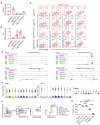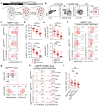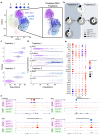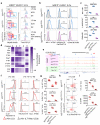Reciprocal transcription factor networks govern tissue-resident ILC3 subset function and identity
- PMID: 34556884
- PMCID: PMC7611981
- DOI: 10.1038/s41590-021-01024-x
Reciprocal transcription factor networks govern tissue-resident ILC3 subset function and identity
Abstract
Innate lymphoid cells (ILCs) are guardians of mucosal immunity, yet the transcriptional networks that support their function remain poorly understood. We used inducible combinatorial deletion of key transcription factors (TFs) required for ILC development (RORγt, RORα and T-bet) to determine their necessity in maintaining ILC3 identity and function. Both RORγt and RORα were required to preserve optimum effector functions; however, RORα was sufficient to support robust interleukin-22 production among the lymphoid tissue inducer (LTi)-like ILC3 subset, but not natural cytotoxicity receptor (NCR)+ ILC3s. Lymphoid tissue inducer-like ILC3s persisted with only selective loss of phenotype and effector functions even after the loss of both TFs. In contrast, continued RORγt expression was essential to restrain transcriptional networks associated with type 1 immunity within NCR+ ILC3s, which coexpress T-bet. Full differentiation to an ILC1-like population required the additional loss of RORα. Together, these data demonstrate how TF networks integrate within mature ILCs after development to sustain effector functions, imprint phenotype and restrict alternative differentiation programs.
© 2021. The Author(s), under exclusive licence to Springer Nature America, Inc.
Conflict of interest statement
The authors declare no competing interests.
Figures














Comment in
-
Transcriptional control of mature ILC3 function and plasticity: not just RORγt.Cell Mol Immunol. 2022 Feb;19(2):142-144. doi: 10.1038/s41423-021-00816-3. Epub 2022 Jan 7. Cell Mol Immunol. 2022. PMID: 34992276 Free PMC article. No abstract available.
References
Publication types
MeSH terms
Substances
Grants and funding
LinkOut - more resources
Full Text Sources
Molecular Biology Databases
Miscellaneous

